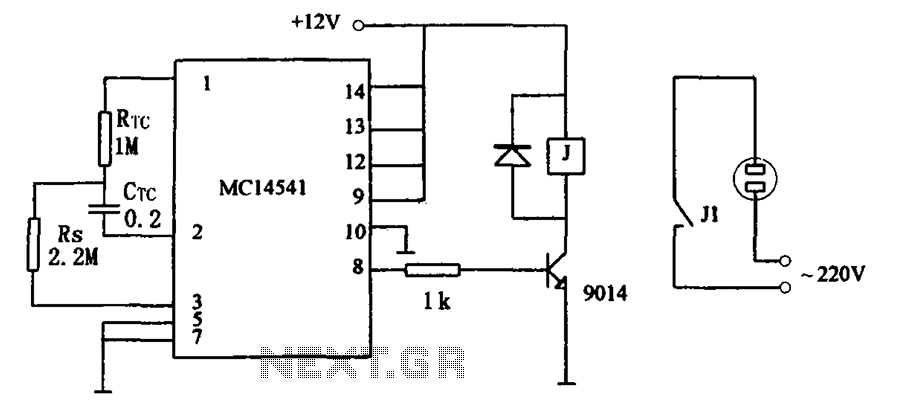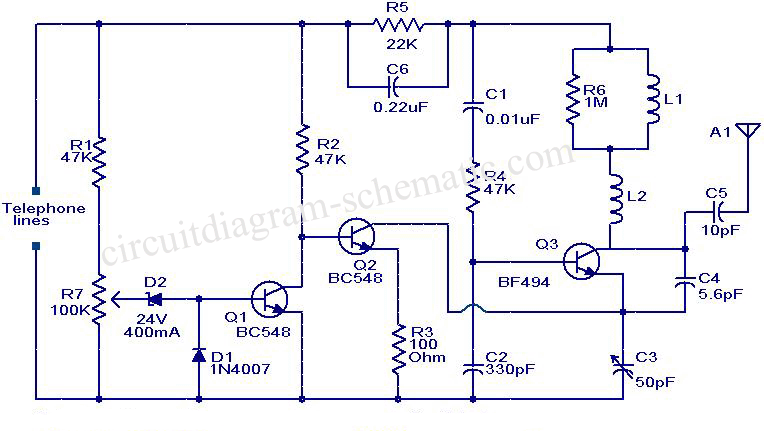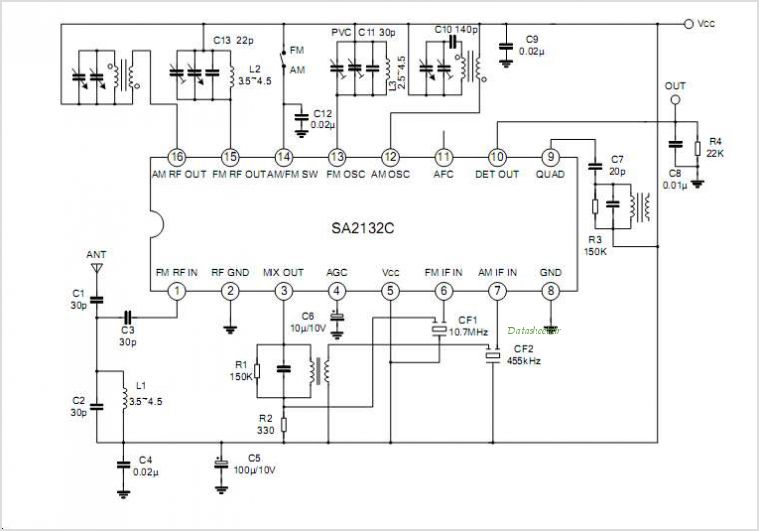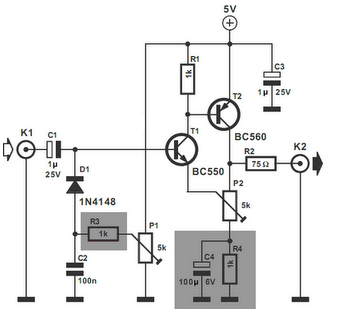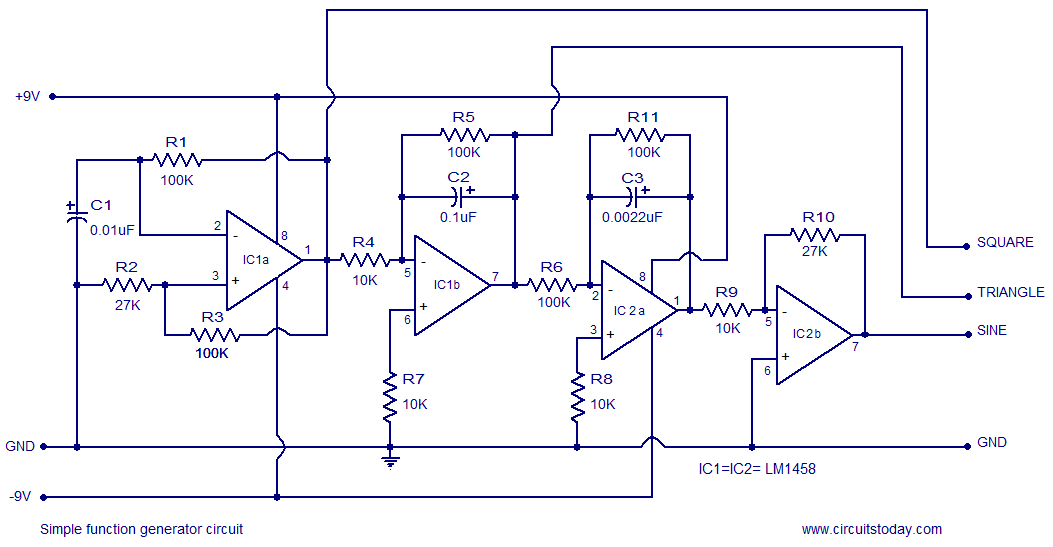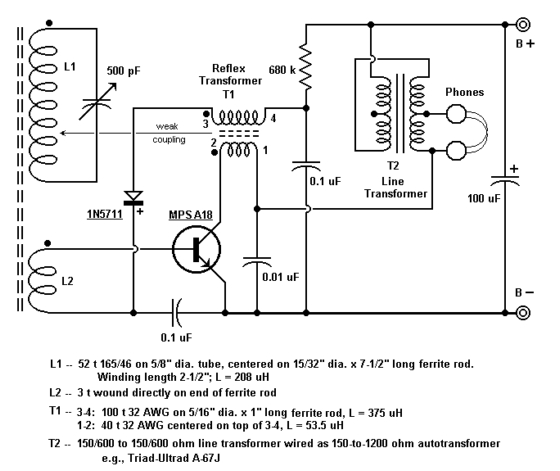
A Simple Radio Receiver
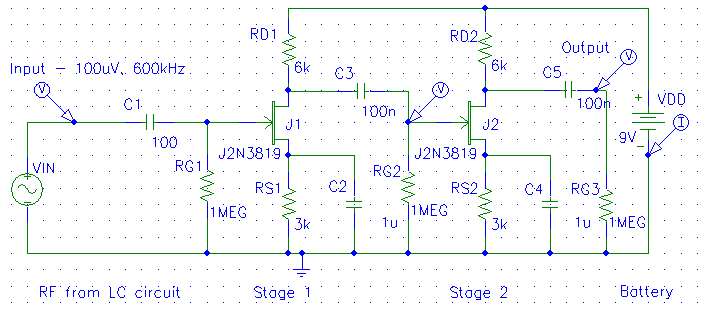
The diagrams below illustrate the development of a simple modular radio receiver based entirely on circuits and devices studied during the Part IA course on Linear Circuits and Devices. This receiver may not revolutionize the market; however, it aims to demonstrate how the circuits and principles being studied contribute to the field of electronic circuit design. A crystal set operates without a battery, deriving its power solely from the energy harvested from radio waves received by the antenna. The design incorporates a resonant LC (or tuned) circuit connected to a large aerial or antenna. Many amateur experimenters constructed crystal sets, often using a tuner inductor coil wound on a tubular box or a drinking glass. At that time, the semiconductor diode had not yet been invented, so the extraction of the audible modulation signal from the transmission relied on the non-linear electrical properties of a crystal, typically a piece of coke or galena. In early designs, a "cat's whisker"—a fine piece of wire—was adjusted through trial and error to create a suitable contact with the crystal. The crystal set had several limitations: it required a large aerial (antenna), an earth connection, the cumbersome cat's whisker, and the weak signal could only be listened to by one person at a time using headphones. Soon after, crystal sets were replaced by valve radios equipped with loudspeakers and powered by batteries. During World War II, crystal sets were utilized by prisoners of war in camps to listen to news from home, showcasing significant ingenuity in improvising necessary components. The design presented here is somewhat more complex than strictly necessary, but some adaptations make it easier to develop the design by adding amplifiers and other stages as they are encountered in the course. Circuit (a) displays the LC resonant circuit consisting of L1 and VC1, which is used to select or tune the required frequency and station. The inductance is 729 µH, and VC1 can be adjusted within a range of 30 to 234 pF. This results in a resonant frequency range of approximately 400 to 1075 kHz, encompassing a substantial portion of the Medium Wave frequency band. L1 is a coil of wire wound on a ferrite rod, a material with high magnetic permeability, which allows for a smaller number of turns to achieve a given inductance compared to an air-core coil. This design maintains low winding resistance and enhances the Q factor, resulting in a narrower resonance peak and improved rejection of unwanted frequencies. VC1 is a variable capacitor, with capacitance adjusted by rotating a knob that controls the overlap of small parallel plates. The capacitance can never be reduced to zero due to residual capacitances inherent in its structure. Additionally, stray or parasitic capacitances from connecting wires, circuit boards, and other elements must be considered, although careful construction can minimize these to a few tens of pF. The signal from the antenna, which may be a few tens of microvolts or hundreds for a nearby station, is introduced to the LC circuit either through a small capacitance or, as in this case, through a second coil L2 wound atop L1, with its other end connected to earth. This configuration acts like a transformer; currents flowing in L2 create a changing magnetic flux that induces an emf in L1. Medium Wave transmissions utilize Amplitude Modulation, wherein the amplitude of the transmitted radio signal or carrier is modulated by another audible frequency signal, such as speech or music. The receiver must extract or detect this audio signal by separating it from the carrier, which can be achieved using a diode detector. The signal is introduced via capacitor C7.
The modular radio receiver design employs several critical components to achieve its functionality. The LC circuit, consisting of the inductor L1 and variable capacitor VC1, serves as the heart of the tuning mechanism. The inductance of 729 µH combined with the variable capacitance allows for fine-tuning within the Medium Wave band, enabling the user to select different radio stations. The choice of ferrite material for L1 is particularly advantageous, as it enhances the inductive properties while minimizing the physical size of the coil, thus improving overall efficiency.
The auxiliary coil L2 functions as a coupling mechanism, facilitating the transfer of energy from the antenna to the LC circuit without requiring direct connection, which could lead to signal loss or interference. This transformer-like behavior is essential for amplifying weak signals captured from the airwaves, making it possible to listen to distant broadcasts.
The use of a diode detector is critical in the demodulation process, as it allows for the extraction of the audio signal from the amplitude-modulated carrier wave. The configuration of capacitor C7 plays a vital role in this process, ensuring that the audio frequencies are effectively coupled to the output stage of the receiver.
Overall, the design of this modular radio receiver exemplifies fundamental principles of electronics, showcasing the integration of passive components to create a functional device capable of receiving and demodulating radio signals. This project not only serves as an educational tool but also highlights the historical significance of crystal sets in the evolution of radio technology.The diagrams below detail the development of a simple modular radio receiver based entirely on circuits and devices studied during the Part IA course on Linear Circuits and Devices. This receiver may not take the market by storm! However, we hope it will help illustrate how the circuits and principles we are studying all c ontribute to the art of electronic circuit design. A crystal set does not have a battery. It runs completely from the energy extracted from radio waves it picks up from the antenna. A resonant LC (or tuned) circuit coupled to a large aerial or antenna was used. Many amateur experimenters constructed crystal sets, often with the tuner inductor coil wound on a tubular box or a drinking glass. At this time the semiconductor diode had not been invented, so extracting the audible modulation signal from the transmission relied on the non-linear electrical properties of the `crystal`, typically a piece of coke or galena.
In early sets a "cat`s whiskers" - a fine piece of wire - was adjusted by trial and error to make a suitable contact with the crystal. There were many limitations to the crystal set: it needed a big aerial (antenna), an earth connection, the clumsy cat`s whisker, and the weak signal could only be listened to by one person at a time with headphones.
Very quickly the crystal set began to be replaced by valve radios with loudspeakers, powered by batteries. In World War II, crystal sets were used by prisoners of war in prison camps to listen to news from home.
Much ingenuity went into improvising the necessary components. The design shown here is a little more complex than strictly necessary, but some of the adaptations incorporated make it easier to develop the design, adding amplifiers and other stages as we meet them in the course. Circuit (a) alongside shows the LC resonant circuit comprising L1 and VC1 used to select or tune the required frequency and station.
The inductance used is 729 uH, and VC1 can be varied over a range 30 to 234 pF. That means the range of resonant frequencies is about 400 to 1075 kHz, which includes a good part of the Medium Wave band of frequencies. L1 is a coil of wire wound on a ferrite rod. Ferrite is a material with a high magnetic permeability - that simply means that that to achieve a given inductance, a smaller number of turns is required than if the coil had an air core.
That keeps its winding resistance low, and enhances the Q, which in turn means the resonant circuit has a narrower resonance peak, and is better at rejecting unwanted frequencies. VC1 is a variable capacitor, in which the capacitance is varied by rotating a knob, which controls the extent to which a set of small parallel plates are enmeshed.
The capacitance can never be reduced to zero, of course, owing to the residual capacitances due to its structure. To these figures must be added any stray or parasitic capacitances arising from the connecting wires, circuit board, and other elements.
These can never be eliminated, but careful construction aims to keep them down to a few tens of pF. The signal from the antenna (perhaps a few tens of microvolts, or hundreds for a nearby transmitting station) is introduced to the LC circuit either through a small capacitance, or, as in this case, by means of a second coil L2 wound on top of L1, with its other end connected to earth. This behaves like a transformer - currents flowing in L2 generate a changing magnetic flux which cuts L1 and induces an emf in it.
Transmissions on Medium Wave frequencies are by Amplitude Modulation. The amplitude of the transmitted radio signal or carrier is modulated - made to rise and fall - by another signal of audible frequency - for example, speech or music. The receiver must extract or detect this audio signal by separating it from the carrier. One way of doinjg this is by means of a diode detector. The signal is introduced via capacitor C7 🔗 External reference
The modular radio receiver design employs several critical components to achieve its functionality. The LC circuit, consisting of the inductor L1 and variable capacitor VC1, serves as the heart of the tuning mechanism. The inductance of 729 µH combined with the variable capacitance allows for fine-tuning within the Medium Wave band, enabling the user to select different radio stations. The choice of ferrite material for L1 is particularly advantageous, as it enhances the inductive properties while minimizing the physical size of the coil, thus improving overall efficiency.
The auxiliary coil L2 functions as a coupling mechanism, facilitating the transfer of energy from the antenna to the LC circuit without requiring direct connection, which could lead to signal loss or interference. This transformer-like behavior is essential for amplifying weak signals captured from the airwaves, making it possible to listen to distant broadcasts.
The use of a diode detector is critical in the demodulation process, as it allows for the extraction of the audio signal from the amplitude-modulated carrier wave. The configuration of capacitor C7 plays a vital role in this process, ensuring that the audio frequencies are effectively coupled to the output stage of the receiver.
Overall, the design of this modular radio receiver exemplifies fundamental principles of electronics, showcasing the integration of passive components to create a functional device capable of receiving and demodulating radio signals. This project not only serves as an educational tool but also highlights the historical significance of crystal sets in the evolution of radio technology.The diagrams below detail the development of a simple modular radio receiver based entirely on circuits and devices studied during the Part IA course on Linear Circuits and Devices. This receiver may not take the market by storm! However, we hope it will help illustrate how the circuits and principles we are studying all c ontribute to the art of electronic circuit design. A crystal set does not have a battery. It runs completely from the energy extracted from radio waves it picks up from the antenna. A resonant LC (or tuned) circuit coupled to a large aerial or antenna was used. Many amateur experimenters constructed crystal sets, often with the tuner inductor coil wound on a tubular box or a drinking glass. At this time the semiconductor diode had not been invented, so extracting the audible modulation signal from the transmission relied on the non-linear electrical properties of the `crystal`, typically a piece of coke or galena.
In early sets a "cat`s whiskers" - a fine piece of wire - was adjusted by trial and error to make a suitable contact with the crystal. There were many limitations to the crystal set: it needed a big aerial (antenna), an earth connection, the clumsy cat`s whisker, and the weak signal could only be listened to by one person at a time with headphones.
Very quickly the crystal set began to be replaced by valve radios with loudspeakers, powered by batteries. In World War II, crystal sets were used by prisoners of war in prison camps to listen to news from home.
Much ingenuity went into improvising the necessary components. The design shown here is a little more complex than strictly necessary, but some of the adaptations incorporated make it easier to develop the design, adding amplifiers and other stages as we meet them in the course. Circuit (a) alongside shows the LC resonant circuit comprising L1 and VC1 used to select or tune the required frequency and station.
The inductance used is 729 uH, and VC1 can be varied over a range 30 to 234 pF. That means the range of resonant frequencies is about 400 to 1075 kHz, which includes a good part of the Medium Wave band of frequencies. L1 is a coil of wire wound on a ferrite rod. Ferrite is a material with a high magnetic permeability - that simply means that that to achieve a given inductance, a smaller number of turns is required than if the coil had an air core.
That keeps its winding resistance low, and enhances the Q, which in turn means the resonant circuit has a narrower resonance peak, and is better at rejecting unwanted frequencies. VC1 is a variable capacitor, in which the capacitance is varied by rotating a knob, which controls the extent to which a set of small parallel plates are enmeshed.
The capacitance can never be reduced to zero, of course, owing to the residual capacitances due to its structure. To these figures must be added any stray or parasitic capacitances arising from the connecting wires, circuit board, and other elements.
These can never be eliminated, but careful construction aims to keep them down to a few tens of pF. The signal from the antenna (perhaps a few tens of microvolts, or hundreds for a nearby transmitting station) is introduced to the LC circuit either through a small capacitance, or, as in this case, by means of a second coil L2 wound on top of L1, with its other end connected to earth. This behaves like a transformer - currents flowing in L2 generate a changing magnetic flux which cuts L1 and induces an emf in it.
Transmissions on Medium Wave frequencies are by Amplitude Modulation. The amplitude of the transmitted radio signal or carrier is modulated - made to rise and fall - by another signal of audible frequency - for example, speech or music. The receiver must extract or detect this audio signal by separating it from the carrier. One way of doinjg this is by means of a diode detector. The signal is introduced via capacitor C7 🔗 External reference
Warning: include(partials/cookie-banner.php): Failed to open stream: Permission denied in /var/www/html/nextgr/view-circuit.php on line 713
Warning: include(): Failed opening 'partials/cookie-banner.php' for inclusion (include_path='.:/usr/share/php') in /var/www/html/nextgr/view-circuit.php on line 713
